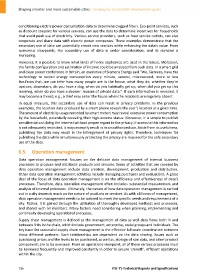Page 726 - Shaping smarter and more sustainable cities - Striving for sustainable development goals
P. 726
conditioning electric power consumption data to determine clogged filters. Eco‐point services, such
as discount coupons for various services, can use the data to determine incentives for households
that avoid peak use of electricity. Various service providers, such as food service outlets, can also
cooperate and share data with electric power companies. These examples demonstrate that the
secondary use of data can potentially create new services while enhancing the data's value. From
numerous viewpoints, the secondary use of data is under consideration, and its demand is
increasing.
However, it is possible to know what kinds of home appliances are used in the house. Moreover,
the family configuration and estimation of income could be analyzed from such data. In a smart grid
and clean power conference in Britain, an executive of Siemens Energy said "We, Siemens, have the
technology to record energy consumption every minute, second, microsecond, more or less
live.From that, we can infer how many people are in the house, what they do, whether they're
upstairs, downstairs, do you have a dog, when do you habitually get up, when did you get up this
morning, when do you have a shower: masses of private data.". If such information is revealed, it
may become a threat; e.g., a thief may enter the house when the residents are regularly absent.
In equal measure, this secondary use of data can result in privacy problems. In the previous
examples, the location data produced by a smart phone reveals the user's location at a given time.
The amount of electricity usage recorded by smart meters may reveal excessive power consumption
by the household, potentially revealing their high‐income status. Moreover, it is simple to publish
sensitive data utilizing the Internet without proper regard to the privacy. If access to this information
is not adequately restricted, it may promptly result in its unauthorized use. Aside from its usefulness,
publishing the data may result in the infringement of privacy rights. Therefore, techniques for
publishing the data while simultaneously protecting the privacy are required for the safe secondary
use of the data.
6.5 Operation management
Data operation management focuses on the delicate data management of internal business
processes to produce and distribute products and services. Some of activities that are covered by
data operation management include data creation, development, production and distribution.
Other data operation management activities include managing purchases and evaluations. A great
deal of the focus of data operation management is on the efficiency and effectiveness of data's
processes. Therefore, data operation management often includes substantial measurement and
analysis of internal processes. Ultimately, the nature of how data operation management is carried
out in a city depends much on the nature of products or services. As with all forms of management,
data operation management needs to be tailored to meet the specific needs and requirements of a
city. Rather, it is gained through the utilization of thoroughly developed methods and processes,
and shared with all members. Many factors need considering when planning, implementing and
continually developing operational processes.
Supply chain management is defined as the management of data as well data flows both in and
between links in the chain, which include government, enterprise, social groups and individuals. The
key issue for successful supply chain management is the effective full‐scale coordination between
these different partners. Such relationships are dependent on the data sharing. Issues such as
purchasing prices and the levels to be purchased, as well as, storage of raw data, and other product
components are to be overseen. From an operations viewpoint, all of these various processes must
be reviewed frequently and improved constantly in order to ensure 'smooth', efficient operations
within the city.
716 ITU‐T's Technical Reports and Specifications

